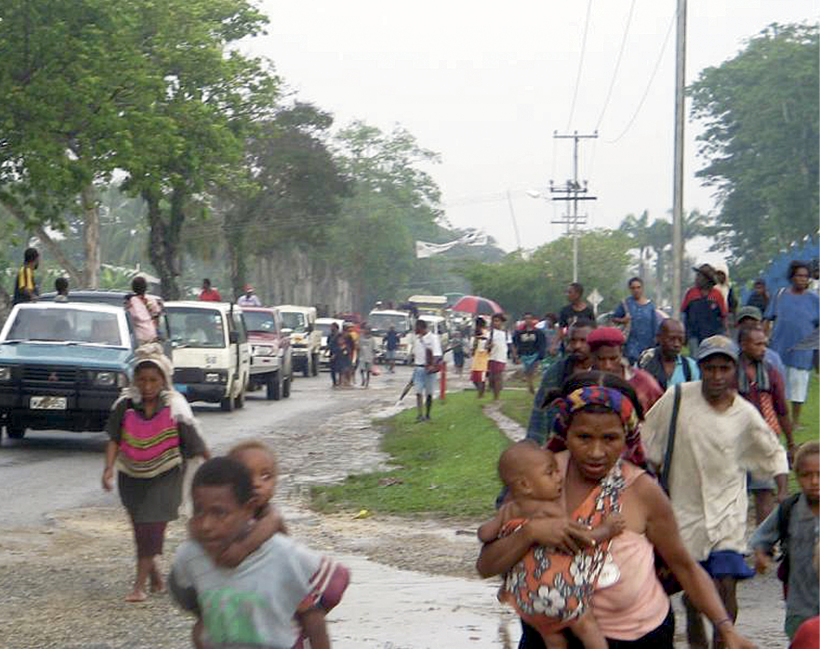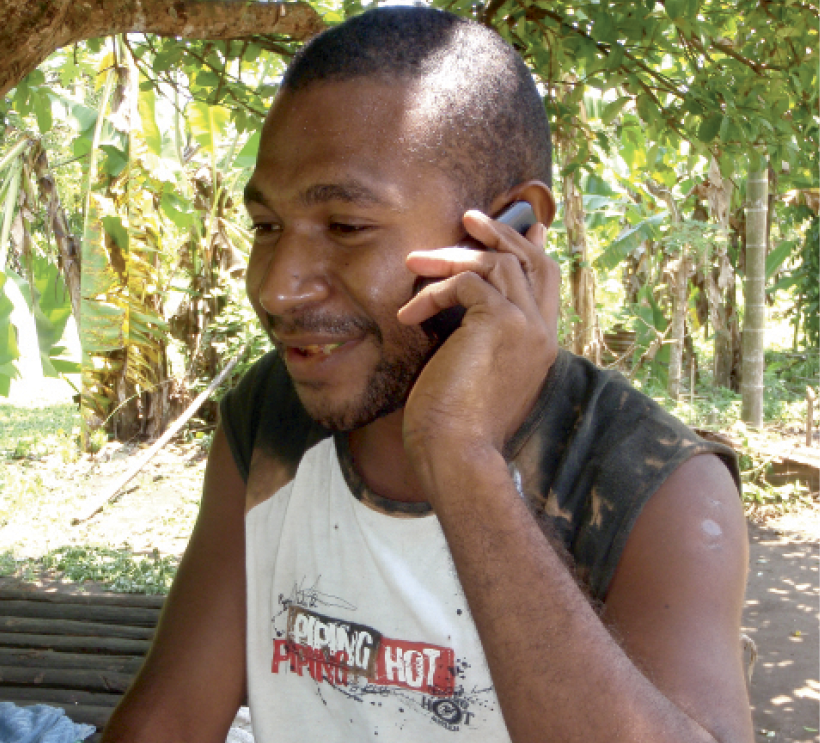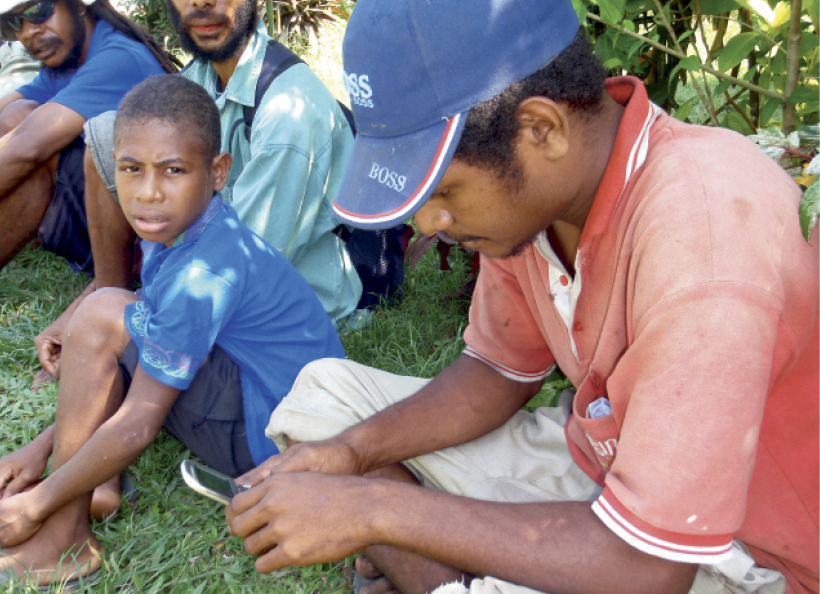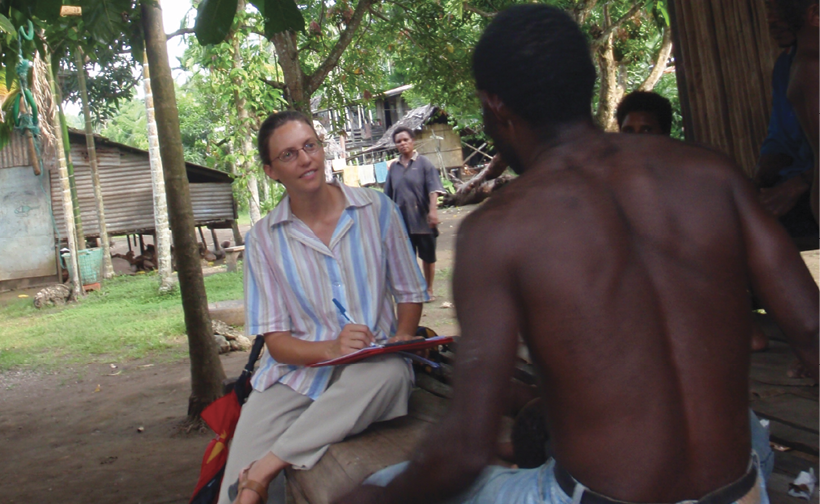
Dr Amanda H A Watson is a communication researcher with expertise in new communication technology for developing nations.
Substantial growth has occurred in the telecommunication sector in Papua New Guinea (PNG) since 2007. Mobile telephony has spread to rural and remote localities, following decades of inadequate telephone services. This paper examines the introduction of mobile telephones into a rural village in PNG, and focuses on information access during emergency situations. It considers three tsunami alerts: one immediately prior to the introduction of mobile phone services in the area, and two which occurred after mobile phone reception became available. The research shows that for people with limited access to information, responses to threats such as tsunamis can be inappropriate and driven by fear and panic. By contrast, when there is reliable, timely information available, measured responses can be adopted. This research demonstrates how the use of newly-introduced communication technologies for handling emergencies may work in practice, benefitting people in poorer, rural communities.
This research is based on the experience of tsunami alerts in Madang Province of PNG. It asserts that changing levels of access to communication technologies are shifting the patterns of communication, as well as the ability to get timely, relevant and reliable information and knowledge.1
PNG is a developing country, north of Australia which has been inhabited for at least 40,000 years (Rynkiewich, 2004, p.17), with European contact since the 1800s (Stanley 1982, pp. 318-319). Although culturally rich, PNG performs poorly in a wide range of development indicators, as reflected by its ranking of 153rd out of 187 countries on the United Nations Human Development Index (United Nations 2011). Over 87 per cent of the people live in rural areas (National Statistical Office of Papua New Guinea 2004) where media access, landline telephone infrastructure and postal services are limited, and computer use is rare (Watson 2011). Since mid-2007, there has been substantial growth in the telecommunication sector, with mobile telephony rapidly rolling out to rural and remote areas.
Data collection methods, which were part of a larger study into mobile telephony in rural villages in PNG, included semi-structured interviews, orally-administered surveys and participant observation. In particular, there was a focus on the experience of tsunami alerts. The research is based on a detailed account by one interviewee, Pancratius ‘Pan’ Lakot, late in 2009, and draws on researcher observations in PNG during three tsunami alerts in 2007, 2009 and 2011.
Megiar is a coastal village in Sumkar District, Madang Province. It is located on the mainland, along a sealed road, some 90 minutes by bus from Madang town. Housing ranges from bush material houses, to semi-permanent houses using mixed materials2 and permanent houses. Some homes have mains electricity connected. Megiar residents have access to water from various sources, such as wells and springs. Some homes have rainwater tanks or drums for storing water. Most people have access to toilets, which are usually pit toilets3 or seawater toilets4. An active marketplace operates in Megiar on a daily basis in a designated area by the road and benefits from passing trade. There are several trade stores, at least two of which are open daily.
Mobile telephone coverage reached Megiar in October 2007 with the construction of a Digicel5 tower at Barikas, a mountaintop village overlooking Megiar. There are no landline telephones, Internet connections or postal services. In a survey of 102 respondents conducted in 2009 in Megiar, it was found that very few people had a television or computer in their home (7.8 per cent and 5.9 per cent respectively) and one third (34.3 per cent) had a functioning radio receiver. The newspaper was the most regularly accessed medium, with 69.6 per cent of respondents having read a newspaper within the previous month. Half of those surveyed owned a mobile phone.
On April 2 2007, a large earthquake occurred in the ocean off the Solomon Islands which led to a tsunami warning being issued for Australia’s east coast, and Pacific island nations including PNG. While beaches were evacuated in Australia as a precaution, in Madang Province, a panic ensued. Many people fled to the hills and in Madang town, which is situated on a low-lying peninsula, the single road out of town was crowded with people hurrying on foot or in vehicles to get away from the expected influx of water. Luckily, there was no need for alarm.

Image: Jeffrey Elapa, 2007
Madang residents fleeing town due to tsunami alert.
On October 8 2009, there was a tsunami warning issued for coastal areas of PNG following an earthquake near Vanuatu. Travelling to Megiar on a public bus that morning, the author received an international phone call with the warning. On arrival in Megiar, the residents were already aware of the warning, having received this information from a government car that was travelling along the coastal road spreading the news via a loudspeaker.
Initially, the villagers seemed calm, indicating they would keep an eye on the ocean, birds and other animals and would have sufficient time to move to higher ground if necessary. A short time later, excitable school children were present in large numbers as their teachers had let them out of class when they received word of the threat. The children were unsupervised, nervous and frightened. They were carrying bags on their backs and apparently some had already retreated to the higher ground of the inland bush areas.
Later in the morning, a respected local leader, Felix Didol, received a mobile phone call from an official in the town saying the warning had been cancelled. Felix set his phone handset to loudspeaker and held it up in the air so that others could hear the update. A large crowd of people, including many school children, gathered around to hear the latest news.
In a number of cases, people in Megiar were sourcing up-to-date information about the status of the tsunami warning via their mobile phones from contacts with Internet access based in Madang town or other urban centres. In one case, town resident Pan Lakot, was able to reassure his relatives in Megiar that there was no need to flee up the hills.
“I was at work when the tsunami threat came about, and we were … monitoring on the Internet the progress of the tsunami threat. Anyway, my brother-in-law called up. He says “brother-in-law, should I move to higher ground?”. And I said, “no, don’t move. Just stay put. We’re monitoring the situation here, on the screen through the Internet. We’ll be alright. Just stay put.” [But he replied,] “No, everyone’s carrying things, and they’re now going up the hills into the bush due to hearing this warning.” [I responded with,] “Just stay put. Don’t move yet. I’ll ring you back. If it’s not looking good, I’ll ring you back on your mobile and let you know.” So that, that was a real plus. And anyway, I called him back and said “no, it’s over now, things are normal, you can all just stay put.” And he said “yeah OK”.”6 (Lakot, 2009)
On March 11 2011, there was an earthquake measuring 8.9 on the Richter Scale which led to thousands of deaths in Japan and large-scale devastation due to tsunamis there. A tsunami warning was issued for many countries around the Pacific, including the northern coast of PNG. At about 7pm, all Digicel users received a tsunami warning text message alert. Felix Didol had already received the warning about an hour earlier by phone from a relative in an urban centre. A town-based family member kept in touch with relatives in Megiar throughout the evening, updating them with information from television coverage.
This experience illustrates how mobile phones can play a role in disseminating up-to-date information about important events, such as tsunami warnings. However, other communication methods, like announcements through loudspeakers, continue to play an important role in information access strategies.
Two key concepts in this paper are information and knowledge. Weigel’s view is that “knowledge is based on information, but it is linked to a specific context, for instance to a specific local context from which it derives its value” (2004, p.20). As information is generally thought of as being factual or concrete (Bennett et al. 2005, p.186-187), it is not usually connected directly to an individual, whereas knowledge is associated with a sense of “personal ownership” (Weigel 2004, p.20) and active engagement with the subject matter (Bennett et al. 2005, pp. 195-196).

Image: Dr Amanda H A Watson, 2009
Megiar resident Christine Yass checking for the latest warnings using her phone.
Linked with both knowledge and information is an important role for communication (Weigel, 2004, p. 20).These three notions interact with, use, or are effected by technological developments (Weigel 2004, pp. 20-21). The term ‘information and communication technologies’ (ICTs) can include “the whole range of technologies designed to access, process and transmit information” (Weigel 2004, p.19), including both the Internet and mobile telephones (Unwin 2009, pp. 26-27; van Dijk 2005, p.204; von Braun and Torero 2006, p.3).
The experiences of tsunami alerts in the Madang area differ in one key respect. After the 2007 event, mobile telephony became available in rural villages, including Megiar. These experiences provide a compelling opportunity to evaluate the relationship between the key concepts of information, knowledge and ICTs. It is argued that mobile phone reception in rural settings, combined with Internet access in urban centres, allows rural villagers to gather reliable, timely information and knowledge. In 2009, Pan Lakot was able to translate the ‘information’ available to him on the computer screen into appropriate ‘knowledge’ relevant to his relatives in a particular locality. During the 2007 tsunami alert, villagers suffered from a lack of information and responded in fear and panic. By contrast, they were able to source reliable, timely knowledge in the second and third instances and could respond appropriately.
Pan Lakot was pleased he could help his relatives during the 2009 tsunami alert. For his relatives, their experience of the tsunami threats was quite distinct. Their reactions were influenced by the amount and kind of information and knowledge they had access to in each instance. In this family, mobile phones made a difference.
“I was able to impart something to people in the village who didn’t have the resource to be able to get the correct information. Because the previous one they packed up and they went, all ran into the bush. And it never struck me, but until, then the recent one, my brother-in-law rang up and I was in front of the screen. [...] So yeah, that was, really, I thought that was really great.” (Lakot 2009)
This shows that
“an informed public is the best defence against any emergencies” (Au 2011, p.27)
as “information enables enhanced control” (Bennett et al. 2005, p.187) over one’s environment and one’s behaviour. In 2011, a public warning system further enhanced speedy access to reliable information. Contact with relatives in urban localities remained an important aspect of the experience in 2011.

Image: Dr Amanda H A Watson, 2009
A visitor from Karkar Island talking on his phone in Megiar.
In another study of emergency use of ICTs in rural districts of developing nations, “ICTs have been found to increase time-efficiency among users” (Chib, Lwin and Jung 2009, p.216) as they eliminate the obstacle of distance. In a place like Megiar where there is limited media access, and no landline telephones or Internet connections, the recent introduction of mobile phones provides a new, modern form of communication that is time-efficient. Previous methods for communicating between Madang town and Megiar involved sending verbal messages with people travelling by bus between these places, or writing notes. It often took two to three days for a reply to be received. For relatives living in other parts of the country, communication with Megiar was even more difficult due to the lack of a full postal service. The time-efficiency of communicating is much improved using mobile phones. This is particularly important during crises such as medical emergencies or tsunami warnings.
Access to mobile telephony is not restricted to urban or privileged populations. Throughout the developing world there has recently been an “unabated uptake of mobile technologies among hitherto unconnected sections of society” (Chib et al. 2009, p. 220; Donner 2008, p.143). The value of mobile telephone systems in emergencies can be greater in rural settings where other ICTs and emergency services (such as ambulances and police) may be non-existent or unreliable.
In the 2009 tsunami “mere access to information” (Weigel 2004, p.20) was not enough for people to make an informed decision about what appropriate action to take. Pan Lakot’s relatives phoned him in search of ‘knowledge’, both in the sense of locally-relevant information and information holding some sense of personal attachment or value (Weigel 2004, p.20). As knowledge can change rapidly and can be shared or exchanged in dialogue (Weigel 2004, p.20), the mobile phone facilitated a conversation that continued in subsequent phone calls throughout the morning until the tsunami alert was lifted.
Weigel outlines several elements of ICTs which have impact on information, knowledge and communication (2004, pp. 20-21). These are:
Following an earlier tsunami alert in the Pacific region, Nadkarni suggested that a disaster warning agency based in New Zealand “could have used the cellular phone system to mass broadcast their messages” (2006, p.8). Two advantages of using mobile telephony are that messages would be distributed almost instantaneously, and recipients would each receive an identical message (Nadkarni 2006, p.8), ensuring greater clarity and less confusion. For Nadkarni, mobile telephony “needs to be put at the very centre of disaster warning systems worldwide” (2006, p.8). In PNG, such a mechanism was used in 2011.

Image: Dr Amanda H A Watson, 2009
Messages and alerts can be distributed almost instantaneously and recipients can receive identical messages.
The recent introduction of mobile telephony into rural villages in PNG, coupled with increasing Internet access in urban centres and the development of websites with suitable, timely information regarding weather and disaster warnings, has changed the availability of information, knowledge and communication for many people in PNG. Mobile telephony and the Internet lend themselves to being useful in times of emergency or danger, specifically in aspects of time-efficiency, interactivity, lower costs, and the capacity for interplay between the two (Weigel 2004, pp. 20-21). While information can be sourced using traditional forms of communication, the information accessed using newer ICTs can be reliable and very timely, and can become knowledge, through the adoption of location-specific information and two-way dialogue.

Image: Dr Amanda H A Watson, 2009
Dr Amanda H A Watson conducting research in Megiar, Madang Province, Papua New Guinea in 2009.
During emergency situations, a multi-pronged approach could prove a valuable strategy for informing citizens. Locally appropriate methods such as a loudspeaker on a motor vehicle are likely to remain useful in conjunction with newly available technologies. This study shows how mobile telephony has enhanced the information-seeking abilities of rural villagers in PNG, particularly in situations when information is needed urgently. Tsunami alert experiences show the value of this communication technology, particularly when used in conjunction with other information access devices (such as Internet connectivity in urban centres).
The author’s field research in Megiar was made possible through receipt of an Endeavour Awards Endeavour Research Fellowship. Dr Lee Duffield of Queensland University of Technology gave feedback on drafts of this paper. Dave Robson also offered his ideas.
Au, T.A., 2011, Analysis of Command and Control Networks on Black Saturday, The Australian Journal of Emergency Management, Vol. 26, No.3, July, pp. 20-29.
Bennett, T., Grossberg, L., and Morris, M., 2005, New Keywords: A Revised Vocabulary of Culture and Society, Blackwell Publishing, Malden, USA.
Chib, A., Lwin, M.O., and Jung, Y., 2009, Adoption of Mobile Phones to Enhance Healthcare: A Technology Acceptance Study of Maternal Care Workers in Indonesia. Media Asia, Vol. 36, No.4, pp. 216-222.
Donner, J., 2008, Research Approaches to Mobile Use in the Developing World: A Review of the Literature. The Information Society, Vol. 24, No.3, pp. 140-159.
Lakot, P., 2009, Interview: Pancratius ‘Pan’ Lakot, Maintenance Controller, HeliNiugini, Madang town end of communication link with Megiar. Madang.
Nadkarni, D., 2006, Lessons From the Tsunami-That-Never-Was. Islands Business, June, p. 8.
National Statistical Office of Papua New Guinea, 2004, Population and Social Statistics. Retrieved 15 October 2008, from http://www.spc.int/prism/country/pg/stats/Pop_Soc_%20Stats/popsoc.htm
Rynkiewich, M. A., 2004, Cultures and Languages of Papua New Guinea, The Melanesian Institute, Goroka, PNG.
Stanley, D., 1982, South Pacific Handbook (2nd ed.), Moon Publications, Chico, USA.
United Nations, 2011, Human Development Index (HDI) - 2011 Rankings. Retrieved 21 May 2012, from http://hdr.undp.org/en/statistics/
Unwin, T., 2009, Development Agendas and the Place of ICTs. In T. Unwin (Ed.), ICT4D: Information and Communication Technology for Development (pp. 7-38), Cambridge University Press, Cambridge.
van Dijk, J.A.G.M., 2005, The Deepening Divide: Inequality in the Information Society, Sage Publications, Thousand Oaks.
von Braun, J., and Torero, M., 2006, Introduction and Overview. In M. Torero and J. von Braun (Eds.), Information and Communication Technologies for Development and Poverty Reduction: The Potential of Telecommunications (pp. 1-20), The Johns Hopkins University Press, Baltimore, USA.
Watson, A.H.A., 2011, Early Experience of Mobile Telephony: a Comparison of Two Villages in Papua New Guinea, Media Asia, Vol. 38, No.3, pp. 170-180.
Weigel, G., 2004, Part 1: ICT4D Today - Enhancing Knowledge and People-centred Communication for Development and Poverty Reduction. In G. Weigel and D. Waldburger (Eds.), ICT4D - Connecting People for a Better World: Lessons, Innovations and Perspectives of Information and Communication Technologies in Development (pp. 15-42), Swiss Agency for Development and Cooperation, Switzerland, and the Global Knowledge Partnership, Malaysia.
Dr Amanda H A Watson is a communication researcher with expertise in new communication technology for developing nations. She completed her PhD in 2011 at Queensland University of Technology, focusing on mobile phones in rural villages of Papua New Guinea.
1. An earlier version of this paper was presented at JEAA Annual Conference, 2010 Journalism Education Association Conference, University of Technology Sydney, November 24 - 26, 2010.
2. A typical semi-permanent house is primarily made of bush materials, with a corrugated iron roof.
3. Pit toilets are bush material structures placed over deep holes in the ground. When the need arises, a new hole is dug elsewhere, the above-ground structure is moved and the first hole is covered over.
4. Seawater toilets are bush material structures erected over the water’s edge.
5. Digicel is one of three mobile phone providers in PNG. It has a large percentage of the market share. The other two providers are bemobile and Citifon.
6. The original interview excerpt contained some phrases in Tok Pisin, a language spoken throughout PNG.